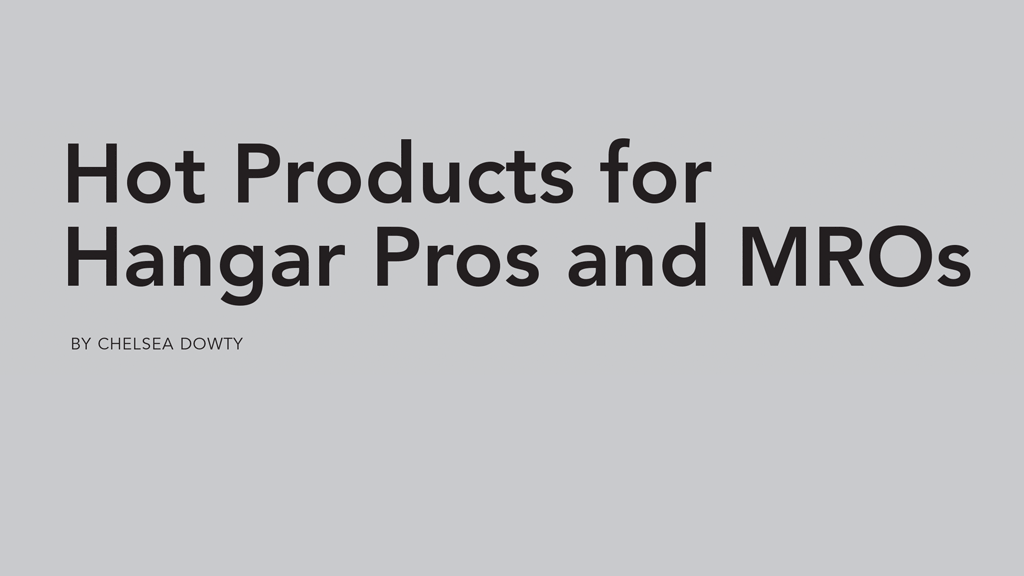Safety, efficiency and cost control are the triumvirate of goals for MRO businesses. As the aviation industry continues to see steady growth, repair stations and MROs must continuously look at aspects of their operation to see how it can be made safer, what processes can be streamlined, how efficiency can be improved and where savings can be found. Using outdated methods and products can mean mechanics face work that takes more time and energy than necessary. Sluggish and unsafe operations can negatively affect a company’s competitive advantage. It also puts a strain on technicians, requiring extra time and physical effort. Work can turn even more costly when mechanics get injured. Workplace injuries can have a huge effect on the bottom line. Check out this roundup of the wide variety of new tools and products out in the marketplace that have been designed to keep employees safe, efficient and organized, by preventing things like falls, repetitive exposure to loud noises, awkward positioning, searching for misplaced tools, slipping and more from happening.
Eidos Ergonomics Ranger Chair
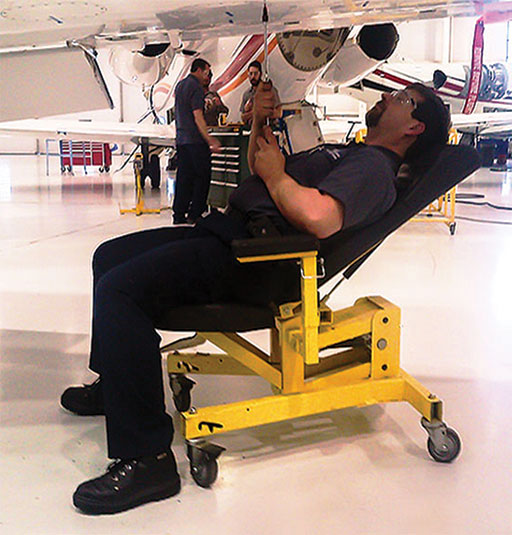
Eidos Ergonomics began in 1987 when their founder, a doctor from Nebraska, was doing some consulting at a Cessna plant. Cessna at the time was using a variety of home-made products and off the shelf-style creepers and stools for production on the Citation line. Cessna asked him to design a highly adjustable ergonomic positioner that would alleviate the fatigue associated with working at those awkward angles. After using that chair (and another product they had designed) for a three-year period, Cessna’s productivity had increased five percent, and employees missing work because of neck, back, and shoulder issues had been reduced to nearly zero. Eidos now produces more than 20 unique models for work on all aspects of aviation maintenance/production for all sizes of private and commercial aircraft. Those very first products are still in use today, a testament to the longevity of the products. One of these models is the Model 117GSW Ranger Chair. “This is one of our more popular models,” according to Darryl Rivers, Eidos vice president. “And when we exhibit at the trade shows, this product seems to garner the most interest.” What is unique about this chair is that it has independent vertical and back recline adjustment which allows the user to be totally supported when working in prolonged overhead positions. This chair has a vertical lift from 18 to 30 inches.
AllProtect Protective Barrier
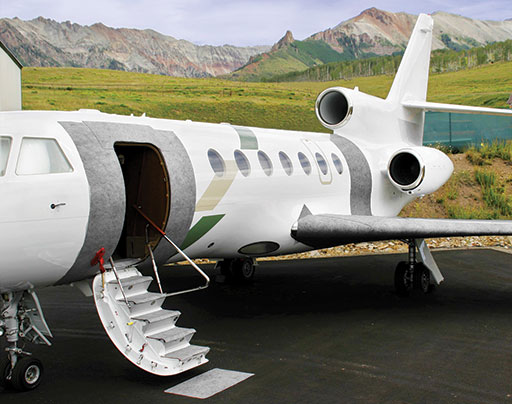
ALLProtect originally partnered with WestStar Aviation in Colorado to develop a non-slip, protective product that could be used on their aircraft. They worked with WestStar for six months, getting feedback on what worked, and what didn’t, for their aircraft. “ALLProtect spent this time developing specific sizes for the aviation industry,” says Mary Altman, director of Sales. ALLProtect is a padded, non-slip protective covering made from a 98 mil, padded, non-woven, durable top layer and used to protect interior and exterior surfaces of aircraft during manufacturing, maintenance and repairs. The backing is made of a plastic film that creates a liquid barrier against spills, is highly absorbent, and has a strong adhesive composite that leaves no residue on removal. ALLProtect comes in two main sizes, small rolls for interior uses like carpet, cabinets, entryway, windows and light bodied jets; and large rolls for exterior uses like stair treads, wings, delta fins, and leading edges. ALLProtect was named a top 10 new maintenance product by a peer reviewed committee at the NBAA 2018 Maintenance Conference. Custom cutting is available.
Surefire EarPro Curve Flange Hearing Protection
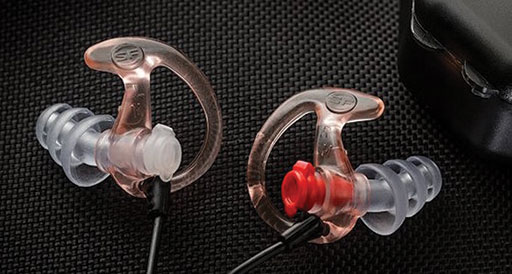
Designed by an audiologist who understands not only the dynamics of hearing, but also the structure of the ear, EarPro says it is the world’s only curved flange hearing protection. According to EarPro, the number one disability claim filed against companies is hearing loss. “Companies often use disposable foam earplugs because they are inexpensive, James Schram, senior global sales manager says. “They can purchase foam plugs for as little as 11 cents a pair. An average worker will use a minimum of four pairs, a cost of 44 cents per worker, per day. When you factor in that there are 260 work days in a year, that equates to five boxes equaling an average of $114.40 per worker, per year. For a company with 200 employees, they would be spending almost $23,000 per year on ear plugs.” EarPro has a six-month life cycle and is designed for extended daily wear. EarPro says its design takes into consideration that workers are more connected than ever. Parent company Surefire designed and patented the Universal Acoustic Coupler or UAC. Built for integration with EarPro, the UAC brings communication and non-electronic hearing protection together allowing the user to stay connected as they protect their hearing.
Tork Wipes
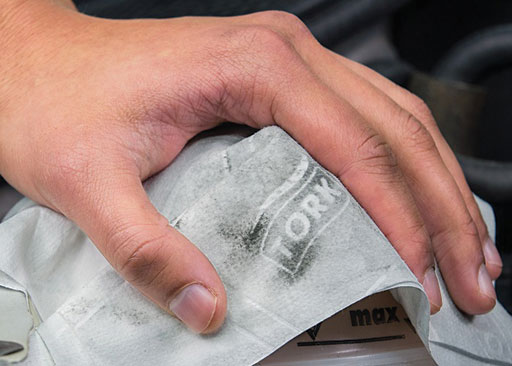
Airline mechanics spend years training and have sophisticated tools to be able to work on aircraft and be responsible for the safety of passengers’ lives. However, many of them are still using rags for wiping and cleaning. Cleaning requirements include general maintenance of engines and aircraft, to more sensitive tasks such as cleaning the cockpit, interiors or fuel tanks. MRO work often requires the use of solvents, and with only rags to use, technicians are potentially being exposed to higher levels of VOC emissions. Rags can be completely soaked in solvent chemicals left lying around the workplace is unhygienic and unsafe. Industrial wipes are the next generation of cleaning tools. The products ensure cleaning and wiping become tasks that can be done relatively quickly. “Tork Wipes are soft, flexible and work well for cleaning oil and grease. Maintenance tasks can be completed more quickly which helps increase worker satisfaction and productivity,” the company says. Tork Wipes come with a system of dispensers that can be placed at workstations, minimizing time wasted walking across the hangar to collect or dispose of rags.
PROTO Industrial Tools Foam Modular Set
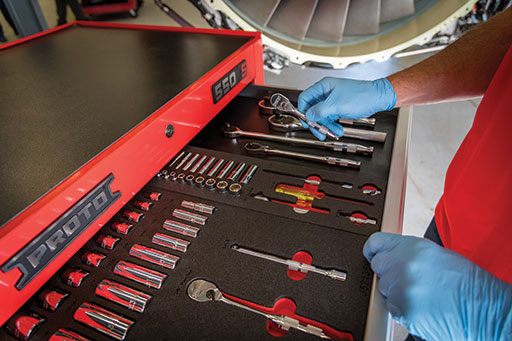
PROTO’s history in the aviation industry starts back in World War II. The U. S. military went looking for a supplier to manufacture high quality tools for use in the Army and Air Force. As a result of their support during WWII, PROTO received four Army-Navy Excellence awards. They have more than 1500 tools that have been designed to meet aerospace specifications. PROTO says they strive to bring innovations to safety and tool control. Their foam full modular sets provide a control to tools accountable. They also help prevent foreign object debris hazard by having a quick visual reference — every tool has a place, every tool in its place. It allows for a quick indication that a tool is missing. “The foam modular sets also lower costs for companies needing to constantly replace missing tools,” says Nick Filipone, PROTO product manager. Their tools are made in the United States and are committed to the highest dedication to safety.
TriSoft Edge Covers
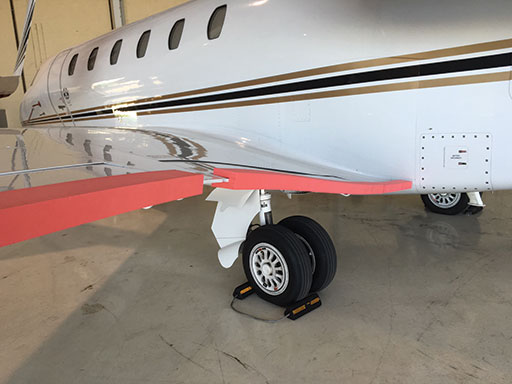
Joe Garland and his brother came up with idea for TriSoft in late 1990s. They had an aircraft cleaning company and as they were working around aircraft they would occasionally hit their heads on various parts of the aircraft. In those days, companies were using bits of junk left in the hangers to put on the edges and corners of planes to combat this. That’s when Garland had the idea to design, make and patent airplane safety covers. Products like their original T100 Trailing Edge Cover, are made from high quality, closed cell, cross link foam. This foam is UV, chemical and fuel resistant. “The safety covers hold up to time and protect the aircraft and personnel from injury during maintenance, manufacturing, cleaning, or during hanger storage,” Joe Garland, CEO and owner of TriSoft says. “TriSoft boasts more than 50 products and is open to redesigning or retrofitting our product for any need,” he added.
Coolture Cooling Vests

Coolture was founded after designer Van DiBernardo was diagnosed with multiple sclerosis. Battling with a cumbersome, unattractive cooling vest that he wore to battle heat intolerance, he decided the product could be improved and created his own design. CEO and president of Coolture, Luanne DiBernardo, who is Van’s sister, “realized that there were many applications for their vests across multiple industries, professions, and consumers.” When the body cannot get rid of excess heat, it will store it. As the body continues to store heat, workers begin to lose concentration and may become irritable, sick, or in extreme cases even die. Every year, thousands of workers become ill from occupational heat exposure, leading to heat injury and heat stroke. Cooling the core body eliminates the mental and physical exhaustion that can lead to accidents on the job, while also helping to prevent heat injury. Workers most at risk of heat stress include those who are 60 years of age or older, are overweight, have heart disease or high blood pressure, or take medications that incite heat intolerance. The Coolture classic vest is made from durable, athletic, exterior fabric and has 100 percent memory recall that uses Outlast “space age” technology, developed for NASA that absorbs and stores body heat. 3M Thinsulate prohibits the sun from affecting the CoolPaks inside the vest. Similar to dry ice, Coolture CoolPaks freeze colder than ice or gel, remain colder longer and weigh less than ice or gel. These versatile vests can be heated to provide warmth in cold climates as well.
Mototok Tug
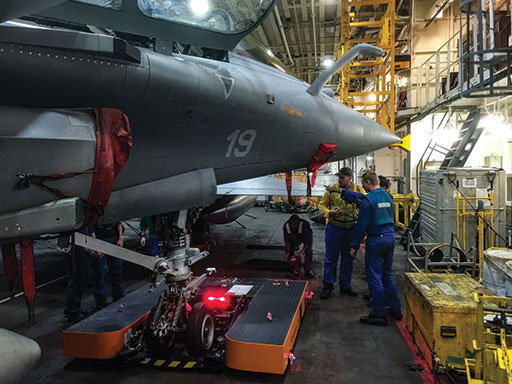
Mototok founder, Kersten Eckert, was inspired to create a solution to his growing frustration from the difficulty in maneuvering aircraft while on the ground. The process requires multiple people, a pilot ready at the brake inside the aircraft, and more time than seemed reasonable, he thought. And even with all that, aircraft were not immune to hanger rash. Eckert decided to develop a better solution after his own Cirrus SR20 was damaged while someone else was trying to get to their plane in a crowded hanger. “These battery powered industrial tugs provide an all around view by a remote control, handled by a single person,” says Paul Acri, sales manager. “This allows the user to walk around the plane as they are maneuvering it in and out of the hanger.” Mototok can be used for all aircraft up to 195 tons and is hands free with no connection the nose gear.
Grypmat Tool Mat
F-16 Air Force mechanic Tom Burden invented Grypmat as a solution to a problem many aircraft mechanics face: where to set down tools while working on an aircraft. Grypmat is a high-performance, flexible, non-magnetic, non-slip, chemical resistant, anti-static, rubber tool mat. Burden says he had seen mechanics in many hangars use commonplace items like egg cartons, coffee cups, or muffin tins to keep tools handy. But all these methods of on hand tool transportation and accessibility can cause damage to the fiberglass and exteriors of planes. “Gypmat was inspired after seeing an anti-slip mat on the dashboard of my mom’s car for her cell phone,” Burden says. After making a pact with a friend and neighbor, Burden decided to pitch Grypmat to investors on the popular TV show, Shark Tank. Bringing a jet on stage and pitching his product, Burden received support from three of the five investors, Mark Cuban, Lori Greiner, and Richard Branson. The product was debuted at the 2016 EAA AirVenture Oshkosh and Burden says by the end of the show he had sold out his inventory. “Gripmat comes in three sizes and keeps your tools accounted for, while protecting airplane surfaces,” Burden says.
Lighthouse Safety Fall Protection Systems
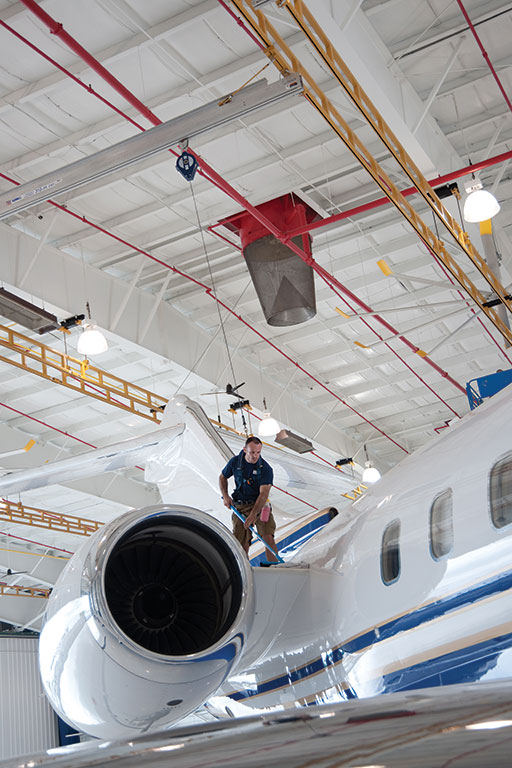
Falls continue to be at the top of OSHA citations for companies and two workers die each day due to falls. “In a fall, in .67 seconds you’ve traveled seven feet, that is not enough reaction time to grab hold of anything, giving the faller 50/50 chance of surviving a fall 15-30 feet,” says Lighhouse Safety Owner John Corriveau. Years ago, a Gulfstream facility required a fall protection system be integrated into their workspace and approached Lighthouse Safety. They have since gone nationwide in the aviation industry with their fall protection products. Lighthouse Safety has been doing engineering, training and installation for fall protection systems for more than 30 years. “We engineer systems for any type of hanger, with the option for low trigger heights of 5-7 feet,” says Corriveau. They have the ability to provide engineered drawings before installation to show full coverage for each specific hanger. These engineered systems help businesses and their facilities meet safety standards set by OSHA and ANSI. Lighthouse Safety also provides post installation training.
Latchways WinGrip
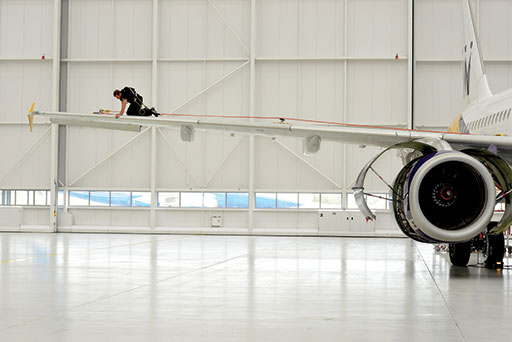
Latchways designs a range of engineered, cable-based fall arrest systems. The WinGrip vacuum anchor system was developed with aircraft engineers as a method of fall protection for those working at height on aircraft. After an Airbus mechanic experienced a fall from an aircraft, the airline realized that the fixed overhead system was not enough. “The airline approached John Lindfield of Rota Limited to help them find a better solution and the idea for the single, vacuum anchor point fall protection system was created. Lindfield had the idea but did not have ability to produce the product, so he approached Latchways for help,” says Simon Francis, head of Sales. WinGrip has lightweight, portable anchors that weigh less than six kilograms and work on wet or dry surfaces, inside hangars or on the ramp. They are easy to install for aircraft wing and fuselage maintenance and have a simple hands-free operation. The systems are safe even with fuel tanks open. They run on compressed air or nitrogen, have no electrical requirement, and there is no metal on metal contact.
LockNClimb Safety Ladders
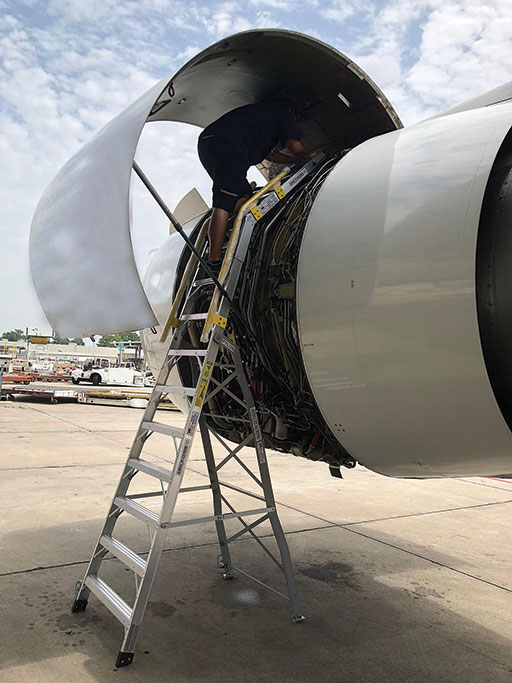
LockNClimb was founded by Jeff Green who had an employee suffer injuries from a ladder fall. He noticed current ladders used in certain situations
did not provide adequate protection or safeguards and decided to design something better. Eight years later, LockNClimb has more than 70 products in its catalogue being used by mechanics in hangers, engine shops and on the flight lines of most major commercial airlines and freight carriers around the world. LockNClimb ergonomic safety ladders enable mechanics to work between the rails to keep spines straight and avoiding back injuries. Extra wide comfort treads provide additional stability and help prevent foot thrombosis. The ladders are lightweight, sturdy and exceed OSHA and ANSI standards. They can be moved by one person and set up quickly, allowing safe working access to engine parts, landing gear and all maintenance points. The ladders come equipped with rubber padding to protect aircraft finishes and rubber bumpers to protect the ladders. LockNClimb ladders have less than a one percent component replacement rate during continual use for three years in the demanding aircraft maintenance environment, the company says.
8tree dentCHECK
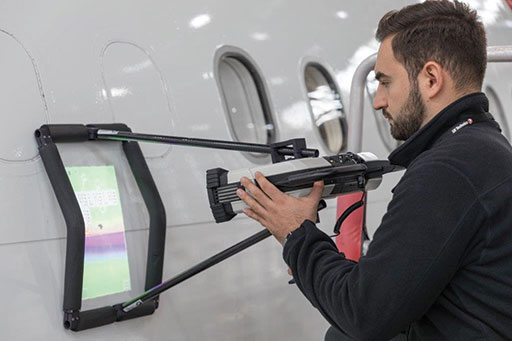
8tree’s journey began six years ago aimed to make surface inspection tools that combine high-speed 3D analysis, Augmented Reality (AR) and handheld-portability, to solve a variety of chronic surface measurement problems, while delivering actionable answers, instead of just data. One products that realizes that original vision is dentCHECK. dentCHECK is a handheld-portable 3D dent-mapping and blend-out analysis tool that delivers actionable “go/no-go” results in seconds, according to 8tree, and provides operators with an enhanced understanding of airframe and floor-panel integrity. dentCHECK says it has demonstrated a 90 percent reduction in damage-mapping and reporting times, compared to traditional manual methods. dentCHECK delivers SRM-compliant answers with consistency, as opposed to the chronic subjectivity of traditional manual measurement methods. The operator-friendly tool works with just one button, is fully self-contained and designed to be used in the maintenance hangar or in the field – no programming, no wires. dentCHECK delivers auditable reports that reduce human-error and turn-around-time, boosting operational efficiency and helping a company’s bottom line.
Human Hoist
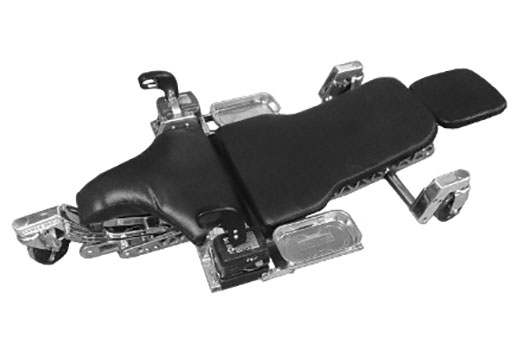
Human Hoist was invented by cousins Eric Brittingham and Kevin Ferguson. The need for Human Hoist was discovered when 18 year old Brittingham and Ferguson spend a day working on Ferguson’s car. Even in the best physical condition of their lives, they were sore the next day. They thought there had to be a better way than climbing up and down to get under the car. A functional prototype was built, and in 2012, was featured on the History Channel’s Invention USA program and was awarded the opportunity to work with a manufacturer. According to Steve Charette, operations manager for the company, “the aviation industry approached Human Hoist after they had marketed on the internet and posted a video that went viral.” They used computer-aided design engineering and made changes to traditional chair ergonomics, customizing it for aviation use. “Human Hoist takes the person and positions them for their specific job. There is no hyperextension,” says Charette. It can be stopped at any position in its travel and works well as a chair, an adjustable stool or a creeper. This is an ergonomic tool that allows mechanics to work further into their careers because they are less likely to injure their backs. Charette also says the chair “also allows someone who is already injured or disabled to do the same work as an able bodied worker.” The dual redundant safety controls with variable speed trigger prevents accidental chair movement. Chair can move at full speed or slowly for accurate positioning. There are options available for stainless steel magnetic tool trays to keep parts, tools, and supplies within reach in all positions. Human Hoist is currently in use by FBOs and MROs as well as manufacturing, transportation, industrial/commercial equipment, rehabilitation and of course, automobile shops.
